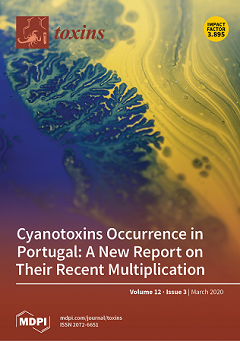The karst viper (
Vipera ursinii ssp.) favours high-mountain dry grasslands in southern and south-eastern Croatia. It is medically less important than other
Vipera species, because of its remote habitat and the very small amount of venom that it injects by its relatively
[...] Read more.
The karst viper (
Vipera ursinii ssp.) favours high-mountain dry grasslands in southern and south-eastern Croatia. It is medically less important than other
Vipera species, because of its remote habitat and the very small amount of venom that it injects by its relatively short fangs. The scientific literature on
Vipera ursinii deals mostly with the morphology, ecology and distribution range of this snake, due to the species’ conservation issues, while the toxinological aspects of its venom have not so far been investigated. Here we report on the composition and biological activity of the
Vipera ursinii ssp. venom. Using a proteomics approach, we have identified 25 proteins in the venom that belong to seven protein families: snake venom metalloproteinase, serine protease, secreted phospholipase A
2, cysteine-rich secretory protein, snake C-type lectin-like protein, serine protease inhibitor and nerve growth factor. The
Vipera ursinii ssp. venom was found to be distinctively insecticidal. Its lethal toxicity towards crickets was more than five times greater than that of
Vipera ammodytes ammodytes venom, while the opposite held in mice. Interestingly, the mode of dying after injecting a mouse with
Vipera ursinii ssp. venom may suggest the presence of a neurotoxic component. Neurotoxic effects of European vipers have so far been ascribed exclusively to ammodytoxins and ammodytoxin-like basic secreted phospholipases A
2. Structural and immunological analyses of the
Vipera ursinii ssp. venom, however, confirmed that ammodytoxin-like proteins are not present in this venom.
Full article






